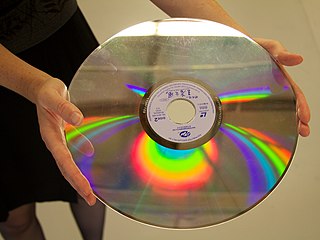
The compact disc (CD) is a digital optical disc data storage format that was co-developed by Philips and Sony to store and play digital audio recordings. It uses the Compact Disc Digital Audio format which typically provides 74 minutes of audio on a disc. In later years, the compact disc was adapted for non-audio computer data storage purposes as CD-ROM and its derivatives. First released in Japan in October 1982, the CD was the second optical disc technology to be invented, after the much larger LaserDisc (LD). By 2007, 200 billion CDs had been sold worldwide.

MPEG-2 is a standard for "the generic coding of moving pictures and associated audio information". It describes a combination of lossy video compression and lossy audio data compression methods, which permit storage and transmission of movies using currently available storage media and transmission bandwidth. While MPEG-2 is not as efficient as newer standards such as H.264/AVC and H.265/HEVC, backwards compatibility with existing hardware and software means it is still widely used, for example in over-the-air digital television broadcasting and in the DVD-Video standard.

Phase Alternating Line (PAL) is a colour encoding system for analog television. It was one of three major analogue colour television standards, the others being NTSC and SECAM. In most countries it was broadcast at 625 lines, 50 fields per second, and associated with CCIR analogue broadcast television systems B, D, G, H, I or K. The articles on analog broadcast television systems further describe frame rates, image resolution, and audio modulation.

Video is an electronic medium for the recording, copying, playback, broadcasting, and display of moving visual media. Video was first developed for mechanical television systems, which were quickly replaced by cathode-ray tube (CRT) systems, which, in turn, were replaced by flat-panel displays of several types.

Video CD is a home video format and the first format for distributing films on standard 120 mm (4.7 in) optical discs. The format was widely adopted in Southeast Asia, South Asia, Greater China, Central Asia and West Asia, superseding the VHS and Betamax systems in the regions until DVD-Video finally became affordable in the first decade of the 21st century.

The VHS is a standard for consumer-level analog video recording on tape cassettes, invented in 1976 by the Victor Company of Japan (JVC). It was the dominant home video format throughout the tape media period in the 1980s and 1990s.

Super Audio CD (SACD) is an optical disc format for audio storage introduced in 1999. It was developed jointly by Sony and Philips Electronics and intended to be the successor to the compact disc (CD) format.
MPEG-1 Audio Layer II or MPEG-2 Audio Layer II is a lossy audio compression format defined by ISO/IEC 11172-3 alongside MPEG-1 Audio Layer I and MPEG-1 Audio Layer III (MP3). While MP3 is much more popular for PC and Internet applications, MP2 remains a dominant standard for audio broadcasting.
A DVD player is a device that plays DVDs produced under both the DVD-Video and DVD-Audio technical standards, two different and incompatible standards. Some DVD players will also play audio CDs. DVD players are connected to a television to watch the DVD content, which could be a movie, a recorded TV show, or other content.

DVD-Audio is a digital format for delivering high-fidelity audio content on a DVD. DVD-Audio uses most of the storage on the disc for high-quality audio and is not intended to be a video delivery format.

The LaserDisc (LD) is a home video format and the first commercial optical disc storage medium, initially licensed, sold and marketed as MCA DiscoVision in the United States in 1978. Its diameter typically spans 30 cm (12 in). Unlike most optical-disc standards, LaserDisc is not fully digital, and instead requires the use of analog video signals.

The Enhanced Versatile Disc (EVD) is an optical-medium-based digital audio/video format, developed by Beijing E-World, as a rival to the DVD to avoid the high royalty costs associated with the DVD format. Its development was supported by the Chinese government. While it was intended to replace the DVD standard in China by 2008, the format had failed to gain traction and ultimately faded into obsolescence.

The White Book refers to a standard of compact disc that stores not only sound but also still pictures and motion video. It was released in 1993 by Sony, Philips, Matsushita, and JVC. These discs, most commonly found in Asia, are usually called "Video CDs" (VCD). In some ways, VCD can be thought of as the successor to the Laserdisc and the predecessor to DVD. Note that Video CD should not be confused with CD Video which was an earlier and entirely different format.
A DVD recorder is an optical disc recorder that uses optical disc recording technologies to digitally record analog or digital signals onto blank writable DVD media. Such devices are available as either installable drives for computers or as standalone components for use in television studios or home theater systems.
cDVD discs, also known as mini-DVD discs, are regular data CDs that contain MPEG-2 or MPEG-1 video structured in accordance with the DVD-Video specifications.
MPEG Multichannel, also known as MPEG-2 Backwards Compatible, or MPEG-2 BC, is an extension to the MPEG-1 Layer II audio compression specification, as defined in the MPEG-2 Audio standard which allows it provide up to 5.1-channels of audio. To maintain backwards compatibility with the older 2-channel (stereo) audio specification, it uses a channel matrixing scheme, where the additional channels are mixed into the two backwards compatible channels. Extra information in the data stream contains signals to process extra channels from the matrix.
MUSE, commercially known as Hi-Vision was a Japanese analog high-definition television system, with design efforts going back to 1979.

DVD-Video is a consumer video format used to store digital video on DVDs. DVD-Video was the dominant consumer home video format in Asia, North America, Europe, and Australia in the 2000s until it was supplanted by the high-definition Blu-ray Disc, before eventually both were replaced by streaming services such as Netflix and Disney+. Discs using the DVD-Video specification require a DVD drive and an MPEG-2 decoder. Commercial DVD movies are encoded using a combination of MPEG-2 compressed video and audio of varying formats. Typically, the data rate for DVD movies ranges from 3 to 9.5 Mbit/s, and the bit rate is usually adaptive. DVD-Video was first available in Japan on November 1, 1996, followed by a release on March 26, 1997 in the United States—to line up with the 69th Academy Awards that same day.
In digital audio, 44,100 Hz is a common sampling frequency. Analog audio is often recorded by sampling it 44,100 times per second, and then these samples are used to reconstruct the audio signal when playing it back.

DeVeDe is a free and open-source DVD and CD authoring utility. DeVeDe produces disk images ready for authoring to CD or DVD, and allows to burn them to CD/DVD discs. The source material may be in any of a number of audio and video formats, and DeVeDe automatically converts the material to formats compatible with audio CD and video DVD standards, as used by CD and DVD player devices. DeVeDe uses other software packages, including MPlayer, MEncoder/FFmpeg, DVDAuthor, VCDImager and mkisofs, to perform the format conversions, and can use K3b or Brasero to burn an ISO image on Ubuntu, or a variety of other software on Windows.













